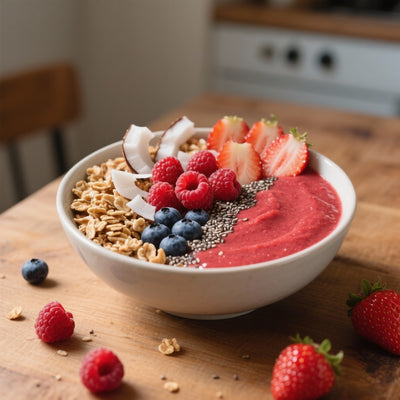The 8 Bioactive Compounds of Shilajit Backed by Science
By the Purlema Team
Shilajit, often called the "tears of the Himalayas," is an ancient substance renowned in Ayurvedic medicine for its regenerative properties. But beyond the legends, what does modern science say? You hear about its benefits for energy, cognition, and longevity, but you might wonder: what makes this black resin so powerful? The answer lies not in a single miracle ingredient, but in a complex and synergistic matrix of bioactive compounds. This article unveils the eight molecular pillars of Shilajit, the best-documented components that explain its remarkable effectiveness. Prepare for a journey into the heart of the biochemistry of this treasure of nature.
1. Fulvic Acid: The Conductor of Synergy
If Shilajit were an orchestra, fulvic acid would undoubtedly be the conductor. It is the most well-known compound and one of the most abundant, playing a central role in the resin's overall effectiveness. It is primarily responsible for Shilajit's exceptional bioavailability.
What is Fulvic Acid?
Fulvic acid is a type of humic acid with a low molecular weight, allowing it to easily cross cell membranes. It is the end product of the decomposition of millions of microorganisms and plant matter over thousands of years. This long maturation process gives it a unique chemical structure and a powerful electrolytic charge.
The Ultimate Nutrient Carrier
Think of fulvic acid as an express delivery service for your cells. Its molecular structure allows it to bind to minerals and trace elements (over 84 in Shilajit!) and transport them directly inside cells to where they are most needed. This chelation action dramatically increases nutrient absorption. That's why the minerals in Shilajit are far more effective than isolated mineral supplements. It transforms inorganic minerals into highly bioavailable organo-mineral complexes.
2. Humic Acids: Guardians of Intestinal Health
Often confused with fulvic acid, humic acids are its larger cousins. Although they share similar origins, their higher molecular weight gives them a different but equally crucial role, primarily in the digestive system.
Action on the Microbiota
Unlike fulvic acid, which penetrates cells, humic acids mostly remain in the gastrointestinal tract. There, they act as powerful prebiotics, nourishing the beneficial bacteria in your gut microbiota. A healthy gut is the cornerstone of good immunity and controlled inflammation. They also help maintain the integrity of the intestinal wall, thus preventing leaky gut syndrome.
3. Dibenzo-α-Pyrones (DBP): Power Plants
If you experience a sustained energy boost with Shilajit, thank the Dibenzo-α-Pyrones (DBP). These unique metabolites are considered one of the biochemical signatures of high-quality Shilajit and are at the heart of its anti-aging and energizing properties.
The Secret of Mitochondrial Energy
DBPs act as shields for our mitochondria, the energy factories of our cells. They protect these vital organelles from oxidative stress, a process that degrades them over time. By preserving mitochondrial function, DBPs help optimize the production of ATP (adenosine triphosphate), the body's primary energy currency. The result? More stable energy, improved endurance, and faster recovery. Incorporating Shilajit into your routine can transform your energy management, a topic we explore in more detail on our lifestyle blog .
4. Trace Elements and Minerals: More than 84 Essential Building Blocks
Shilajit is an incredibly rich source of minerals and trace elements. It contains over 84 of them, present in both ionic and organic forms, meaning they are immediately recognized and used by the body.
"Shilajit is not simply a collection of minerals; it is an intelligent matrix where each compound amplifies the effectiveness of the others. It is the very definition of natural synergy."
Minerals in Harmony
Unlike synthetic supplements that can create imbalances, the minerals in Shilajit are present in natural ratios. Among the most important are:
- Iron: Essential for oxygen transport and fighting fatigue.
- Magnesium: Involved in more than 300 enzymatic reactions, crucial for muscle relaxation and sleep.
- Zinc: Essential for the immune system, skin health and hormonal balance.
- Selenium: A powerful antioxidant that protects cells and supports thyroid function.
- Copper: Necessary for collagen formation and iron absorption.
5. Ellagic Acid: The Skin and Cognitive Protector
Ellagic acid is a polyphenol also found in pomegranates and berries, but its presence in Shilajit, combined with fulvic acid, makes it particularly effective. Its antioxidant and anti-inflammatory properties are well documented.
Benefits for the Skin and Brain
Studies suggest that ellagic acid may help protect collagen from degradation, thus contributing to skin health and elasticity. Cognitively, its neuroprotective effects are promising, helping to protect neurons from oxidative stress and supporting memory and concentration.
6. Plant Triterpenes and Sterols: Natural Modulators
These compounds, derived from the plants that formed Shilajit, play an adaptogenic role. An adaptogen is a substance that helps the body adapt to various types of stress, whether physical, chemical, or biological, and to regain its balance (homeostasis).
Hormonal Balance and Stress Response
The triterpenes and sterols in Shilajit may help modulate the response of the HPA (hypothalamic-pituitary-adrenal) axis, our central stress management system. This results in improved stress resilience, reduced cortisol (the stress hormone) levels, and support for overall hormonal balance, particularly with regard to testosterone in men.
7. Essential Fatty Acids: The Fuel of Cell Membranes
Although present in smaller quantities, essential fatty acids like omega-3 and omega-6 are vital components of Shilajit. They are essential for the health of every cell membrane in our body, especially those in our brain.
Support for Brain Health
These fatty acids contribute to the fluidity of neuronal membranes, which is crucial for effective communication between nerve cells. They also play an important anti-inflammatory role throughout the body, including the brain.
8. Amino Acids: The Builders of Life
Shilajit also contains a spectrum of amino acids, the building blocks of proteins. These are essential for countless functions, from muscle repair to the synthesis of neurotransmitters that regulate our mood.
Support for Recovery and Well-being
The presence of amino acids like glycine, glutamic acid, and aspartic acid supports post-exercise recovery, aids in the building of lean tissue, and contributes to the production of key neurotransmitters such as GABA and serotonin. Incorporating it into your diet is easy; discover ideas on our recipe blog .
Conclusion: The Power of the Natural Matrix
You now understand that the magic of Shilajit doesn't come from a single compound, but from the intelligence of nature. It's the perfect synergy between fulvic acid, DBP, over 84 minerals, and all the other compounds that creates this powerful wellness elixir. Each element works together to nourish, protect, and energize the body at a cellular level.
By choosing pure, high-quality Shilajit, you're not just ingesting a supplement, but a complete substance—a matrix of biological information perfected by nature over millennia. Which of these compounds surprises you the most? To learn more about nature's treasures, explore our information blog .











